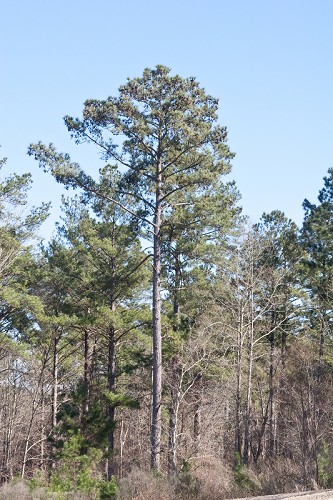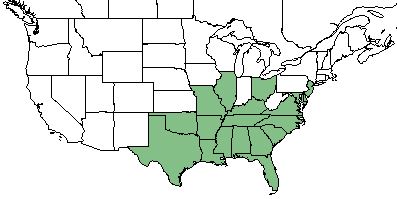Pinus taeda
Common name: loblolly pine [1], old field pine [1]
| Pinus taeda | |
|---|---|

| |
| Photo by John Gwaltney hosted at Southeastern Flora.com | |
| Scientific classification | |
| Kingdom: | Plantae |
| Division: | Magnoliophyta - Flowering plants |
| Class: | Magnoliopsida - Dicots |
| Order: | Pinales |
| Family: | Pinaceae |
| Genus: | Pinus |
| Species: | P. taeda |
| Binomial name | |
| Pinus taeda L. | |

| |
| Natural range of Pinus taeda from USDA NRCS Plants Database. | |
Contents
Taxonomic Notes
Synonyms: none
Varieties: none
Description
P. taeda is a perennial tree of the Pinaceae family native to North America.[2]
Distribution
P. taeda is found in the southeastern corner of the United States excluding Indiana and West Virginia.[2]
Ecology
Habitat
P. taeda proliferates in forests, fields, and pine plantations.[1] Specimens have been collected from palm hammock ear edge of river, open pine woodland, small old field, mesic coastal palm oak hammock, loamy soil near small pond, palmetto flatwoods, open pasture, mixed hardwoods, and pine flatwoods.[3] When exposed to soil disturbance by military training in West Georgia, P. taeda responds negatively by way of absence.[4]
Pinus taeda is frequent and abundant in the Peninsula Xeric Sandhills, North Florida Longleaf Woodlands, North Florida Subxeric Sandhills, Clayhill Longleaf Woodlands, and Upper Panhandle Savannas community types as described in Carr et al. (2010).[5]
Phenology
P. taeda has been observed flowering in March.[6]
Seed dispersal
This species is thought to be dispersed by wind.[7]
Seed bank and germination
Seeds of P. taeda have low viability after one year.[8]
Fire ecology
P. taeda is fire resistant and has a high fire tolerance.[2]
Pollination and use by animals
Pinus taeda has been observed to host species such as Spissistilus festinus (family Membracidae), Graphium sp. (family Papilionidae), members of the Aphididae family such as Cinara sp. and Uroleucon sp., members of the Reduviidae family such as Apiomerus crassipes, Rhynocoris sp. and Zelus tetracanthus, as well as members of the Miridae family such as Phoenicocoris claricornis and Pilophorus laetus.[9]
Conservation, cultivation, and restoration
P. taeda is listed as a weedy or invasive species by the Hawaiian Ecosystems at Risk Project Biological Resources Division.[2]
Cultural use
Tar from these trees can be used as inhalants for treating pulmonary diseases. Salves and oils could be used for acne and skin diseases, intestinal worms, as a stimulant, and as a laxative.
Photo Gallery
References and notes
- ↑ 1.0 1.1 1.2 Weakley, A. S. (2015). Flora of the Southern and Mid-Atlantic States. Chapel Hill, NC, University of North Carolina Herbarium.
- ↑ 2.0 2.1 2.2 2.3 USDA Plant Database https://plants.usda.gov/core/profile?symbol=PITA
- ↑ URL: http://herbarium.bio.fsu.edu. Last accessed: June 2018. Collectors: Loran C. Anderson, R.K. Godfrey, Angus Gholson, Gary Knight, S.W. Leonard, Patricia Elliot, K. Craddock Burks, k. Studenroth, C. Florke, A.G. Shuey, J. Poppleton, D.B. Ward, S.S. Ward, T. Myint, P. Cmanor, S.Snedaker, Kurt Blum, J.M. Kane, T. MacClendon, K. MacClendon. States and counties: Florida (Franklin, Leon, Wakulla, Taylor, Gadsden, Leon, Jackson, Orange, Liberty, Levy, Jefferson, Lake, Escambia, Hamilton, St. Johns, Washington, Calhoun) Georgia (Thomas)
- ↑ Dale, V.H., S.C. Beyeler, and B. Jackson. (2002). Understory vegetation indicators of anthropogenic disturbance in longleaf pine forests at Fort Benning, Georgia, USA. Ecological Indicators 1(3):155-170.
- ↑ Carr, S.C., K.M. Robertson, and R.K. Peet. 2010. A vegetation classification of fire-dependent pinelands of Florida. Castanea 75:153-189.
- ↑ Nelson, G. PanFlora: Plant data for the eastern United States with emphasis on the Southeastern Coastal Plains, Florida, and the Florida Panhandle. www.gilnelson.com/PanFlora/ Accessed: 24 MAY 2018
- ↑ Kirkman, L. Katherine. Unpublished database of seed dispersal mode of plants found in Coastal Plain longleaf pine-grasslands of the Jones Ecological Research Center, Georgia.
- ↑ Kirkman, L. K. and R. R. Sharitz (1994). Vegetation disturbance and maintenance of diversity in intermittently flooded Carolina bays in South Carolina. Ecological Applications 4: 177-188.
- ↑ Discoverlife.org [1]